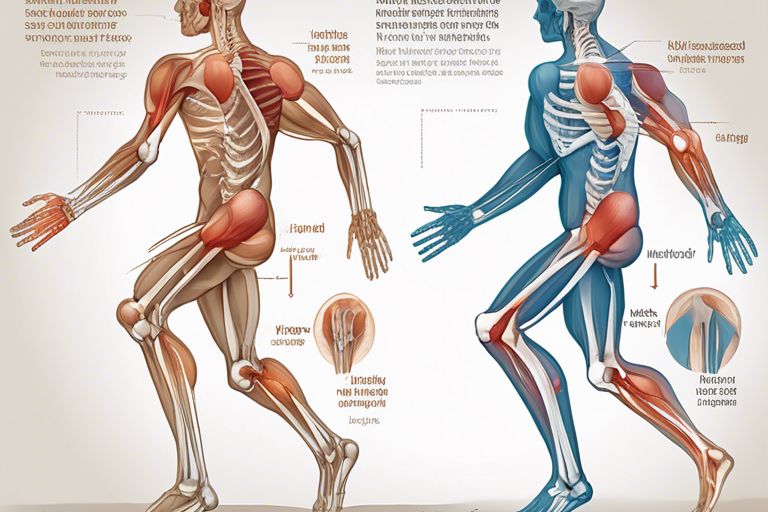Running is an excellent way to improve cardiovascular health and strengthen your muscles, but have you ever wondered how it affects your joint health? Whether you’re a seasoned runner or just starting out, it’s important to understand the impact that running can have on your joints. While running can strengthen your bones and cartilage and improve joint function, it can also put significant stress on your joints, potentially leading to injuries and long-term damage. In this blog post, we’ll explore the relationship between running and joint health, and provide tips for minimizing the risk of joint injuries while still enjoying the many benefits of running.
Anatomy of Joints Affected by Running
The human body is an incredible machine, and running can put a significant amount of stress on your joints. It’s important to understand how running affects the anatomy of your joints in order to prevent injury and maintain good joint health.
Knee Joint Structure and Function
The knee joint is a complex structure made up of bones, cartilage, ligaments, and tendons. When you run, the knee joint absorbs the impact of each step you take. The repetitive pounding can lead to wear and tear on the cartilage, which can eventually result in conditions such as osteoarthritis. Proper alignment, muscle strength, and flexibility are essential for maintaining good knee joint health while running.
Hip and Ankle Joints in Running Dynamics
Your hip and ankle joints also play a crucial role in the dynamics of running. The hip joints provide stability and support while absorbing the impact of each stride. The ankle joints help to propel you forward and provide stability as you push off the ground. Imbalances or weaknesses in these joints can lead to overuse injuries such as tendonitis or stress fractures.
Understanding the anatomy of the joints affected by running is essential for preventing injury and maintaining good joint health. By taking proactive measures to strengthen and support these joints, you can enjoy the benefits of running while minimizing the risk of joint-related issues.
Benefits of Running on Joint Health
Obviously, running has numerous benefits for your overall health, including boosting cardiovascular fitness, improving mental well-being, and helping with weight management. But what about its impact on joint health? Contrary to popular belief, running can actually have a positive effect on your joint health when done in moderation and with proper form. In this section, we will discuss the various ways in which running can benefit your joint health.
Strengthening of Musculoskeletal System
When you run, you are engaging a variety of muscles, tendons, and ligaments in your lower body, including those around the knees, hips, and ankles. The repetitive impact of running helps to strengthen these tissues over time, leading to better support and stability for your joints. Additionally, the stress placed on the bones during running can promote bone density, reducing the risk of osteoporosis as you age. Ultimately, this can lead to a reduced risk of joint injuries and conditions such as arthritis.
Improved Joint Mobility and Lubrication
Another benefit of running for joint health is the improvement in joint mobility and lubrication. As you move through the full range of motion while running, the synovial fluid within your joints is circulated, providing nourishment and reducing friction between the cartilage. This can help to maintain the health of your joints and prevent stiffness and pain. Additionally, the impact of running can stimulate the production of collagen, which is essential for the strength and flexibility of your tendons and ligaments.
Potential Risks of Running on Joints
Despite its many benefits, running can also pose potential risks to your joint health. The impact and repetitive nature of running can lead to overuse injuries and increased wear on your joints, particularly if not approached with care and caution.
Overuse Injuries and Their Prevention
Overuse injuries, such as runner’s knee, shin splints, and IT band syndrome, can result from the repetitive stress of running. These injuries can be painful and limit your ability to continue running, impacting your joint health in the long run. To prevent overuse injuries, it’s crucial to incorporate rest days into your training schedule, vary your workouts to reduce repetitive stress on specific joints, and ensure proper footwear and running form to minimize the impact on your joints.
Understanding Impact Forces and Joint Wear
When you run, your joints experience impact forces as your feet make contact with the ground. Over time, these impact forces can contribute to joint wear, potentially leading to conditions such as osteoarthritis. It’s important to be mindful of the surfaces you run on and consider incorporating low-impact cross-training activities into your routine to reduce the overall impact on your joints. Additionally, maintaining a healthy body weight and incorporating strength training exercises can help to support and protect your joints from excessive wear and tear.
Mitigating Negative Effects on Joints When Running
After learning about the potential negative effects running can have on your joints, it’s important to understand how you can mitigate these risks. By taking certain precautions and following best practices, you can continue to enjoy the benefits of running while reducing the impact on your joint health.
Proper Running Techniques and Posture
When it comes to running, proper technique and posture are essential for minimizing the strain on your joints. Make sure you are running with a straight posture, keeping your head up and shoulders relaxed. Your arms should be bent at a 90-degree angle and swinging naturally with each stride. Additionally, pay attention to your foot strike, aiming for a mid-foot strike to distribute impact more evenly and reduce stress on your joints. Improper running technique and posture can significantly increase the risk of joint injury and pain, so be mindful of your form and make necessary adjustments to lessen the impact on your joints.
Importance of Footwear and Surface Choice
The type of footwear you choose and the surface you run on can greatly impact your joint health. Investing in high-quality, supportive running shoes that are suited to your specific gait and foot shape can provide cushioning and stability to reduce the impact on your joints. Additionally, be mindful of the surfaces you run on. Avoid hard, unforgiving surfaces like concrete whenever possible, and opt for softer surfaces like grass or trails to lessen the stress on your joints. Choosing the right footwear and running surface can play a crucial role in safeguarding your joint health while enjoying the benefits of running.
Conclusion
Following this discussion, it is clear that running can have both positive and negative effects on your joint health. While the impact of running can help to improve joint function and reduce the risk of osteoarthritis, it also puts a considerable amount of stress on your joints, leading to potential overuse injuries. To maintain healthy joints while running, it is important to incorporate proper warm-up and cool-down routines, cross-training exercises, and listen to your body’s signals to avoid pushing it too hard. By taking these precautions, you can continue to enjoy the benefits of running while minimizing the risk of joint issues.




